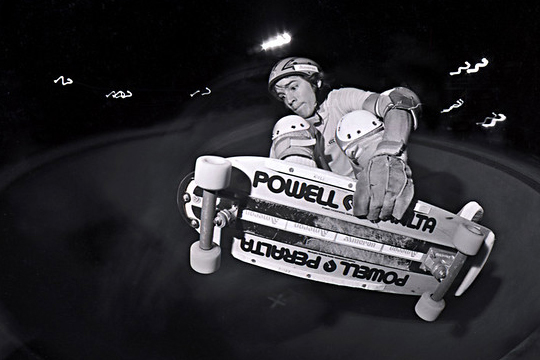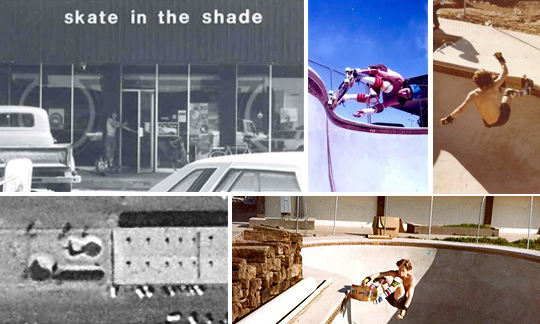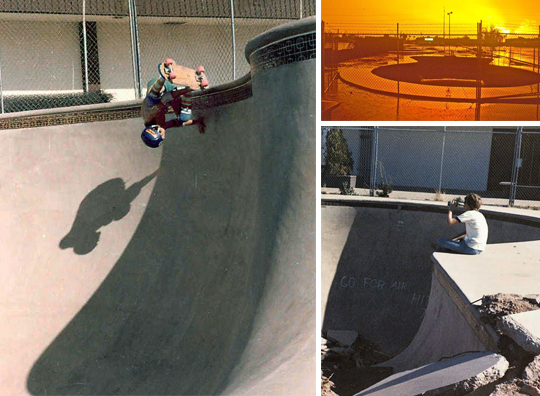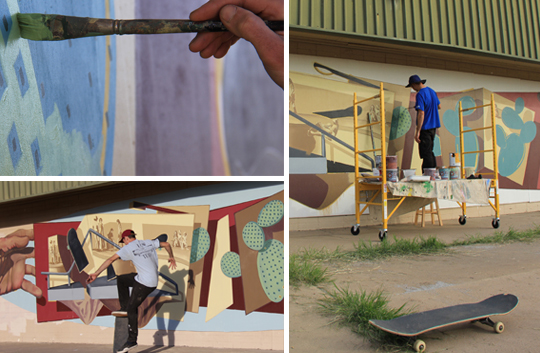Some of Danelle Plaza’s most interesting history actually sits beneath its surface, this includes the story of ‘Skate in the Shade’ – Tempe’s own underground skatepark. For many who remember the singular yet legendary bowl, it pushed young athletes and boards to the limits while offering a place to carve out a community space and testbed for the local skater scene. While the facility only lasted a few years, it represented a renaissance period for skateboard culture and a moment when Tempe would help influence skate park technology and design across the United States. Will Tempe’s ‘Shade’ rise again?
While skate parks are now a common feature in city parks across the United States, they have come a long way from their original roots. The 1970’s represented a transformative period for skateboarding culture and industry – what many consider its Golden Age. Innovation in material technology allowed skateboarders to push their equipment harder along with their own physical abilities, opening up a new range of exploration and growth. Southern California’s drought and surfer influence helped drive skateboarding to new levels of visibility as a sport – inspiring formal competitions and mass media coverage, while spawning a new generation of professional skaters. Investors took notice, resulting in a pulse of privatized skate park development across the United States during the late 1970’s. Each new park was largely its own little experiment. Skate park design was constantly evolving along with the sport, and equally didn’t have a deep well of knowledge to draw from. ‘Skate in the Shade’ at Danelle Plaza was part of this wave of new skate park projects across the United States, but would also make its own unique contribution to the practice of skate park construction and design.


While skate parks are now a common feature in city parks across the United States, they have come a long way from their original roots. The 1970’s represented a transformative period for skateboarding culture and industry – what many consider its Golden Age. Innovation in material technology allowed skateboarders to push their equipment harder along with their own physical abilities, opening up a new range of exploration and growth. Southern California’s drought and surfer influence helped drive skateboarding to new levels of visibility as a sport – inspiring formal competitions and mass media coverage, while spawning a new generation of professional skaters. Investors took notice, resulting in a pulse of privatized skate park development across the United States during the late 1970’s. Each new park was largely its own little experiment. Skate park design was constantly evolving along with the sport, and equally didn’t have a deep well of knowledge to draw from. ‘Skate in the Shade’ at Danelle Plaza was part of this wave of new skate park projects across the United States, but would also make its own unique contribution to the practice of skate park construction and design.

As the story goes, the Skate in the Shade owners had a bold vision that included an extensive outdoor skateboarding facility all incorporated under a massive shade structure, hence “Skate in the Shade”. The project started in 1978 with the opening of a small skate shop with a large skate bowl in the adjacent lot. Skate park designer Wally Holliday and Mesa pool builder Duane Bigelow were brought on for its construction. The skate bowl design was aggressive for its time hosting a 13-foot deep keyhole layout edged with thick tiled coping. However, the quality of the installation made it truly stand out, with Bigelow’s innovative application techniques offering ultra-smooth and seamless concrete surface. The skating experience was so superior to other parks that it quickly gained national recognition amongst professional skaters and the skate park industry. Soon, the likes of Stacy Peralta and Scott Dunlap were testing out the bowl, and Holliday and Bigelow were hired to construct new parks across the United States based on the new installation methods proven in Tempe, including the iconic Cherry Hill Park in Cherry Hill, New Jersey, the original Combi-Pool at Pipeline in Upland, California, and Apple Skate Park in Columbus, Ohio.

As the story goes, the Skate in the Shade owners had a bold vision that included an extensive outdoor skateboarding facility all incorporated under a massive shade structure, hence “Skate in the Shade”. The project started in 1978 with the opening of a small skate shop with a large skate bowl in the adjacent lot. Skate park designer Wally Holliday and Mesa pool builder Duane Bigelow were brought on for its construction. The skate bowl design was aggressive for its time with a 13-foot deep keyhole layout edged with thick tiled coping. However, the quality of the installation made it truly stand out, with Bigelow’s innovative application techniques offering an ultra-smooth and seamless concrete surface. The skating experience was so superior to other parks that it quickly gained national recognition amongst professional skaters and the skate park industry. Soon, the likes of Stacy Peralta and Scott Dunlap were testing out the bowl, and Holliday and Bigelow were hired to construct new parks across the United States based on the new installation methods proven in Tempe, including the iconic Cherry Hill Park in Cherry Hill, New Jersey, the original Combi-Pool at Pipeline in Upland, California, and Apple Skate Park in Columbus, Ohio.
When the first phase opened to the public, skateboarders were able to purchase park membership complete with photo ID card at the skate shop before making their way through a fence into the skate bowl area. Entering the bowl using a small staircase, they took advantage of the bowl’s depth and size, pushing off from the shallow end and rocketing down the abrupt waterfall into the deep end, launching themselves up the face wall and around the perimeter of the bowl. Everyday was an experiment for these niche athletes, exploring the limits of what was physically and technically possible on a daily basis, learning from each other and their own experimentation. Spectators would often surround the bowl, including ‘cowboys’ from the adjacent country bar Bushwackers who were equally impressed by the spectacle. Yet, the potential for accidents and the associated liability proved too much for the industry and a vast majority of parks closed across the country within only a few years. Sadly, Skate in the Shade was no exception. Property owners tried to ‘close’ the park by dumping dirt into the bowl, only to have local skaters continuously dig it out again. Then, finally around 1983, a backhoe was used to smash the edge coping into the bottom of the bowl, and then completely covered it with dense infill.


When the first phase opened to the public, skateboarders were able to purchase park membership complete with photo ID card at the skate shop before making their way through a fence into the skate bowl area. Entering the bowl using a small staircase, they took advantage of the bowl’s depth and size, pushing off from the shallow end and rocketing down the abrupt waterfall into the deep end, launching themselves up the face wall and around the perimeter of the bowl. Everyday was an experiment for these niche athletes, exploring the limits of what was physically and technically possible on a daily basis, learning from each other and their own experimentation. Spectators would often surround the bowl, including ‘cowboys’ from the adjacent country bar Bushwackers who were equally impressed by the spectacle. Yet, the potential for accidents and the associated liability proved too much for the industry and a vast majority of parks closed across the country within only a few years. Sadly, Skate in the Shade was no exception. Property owners tried to ‘close’ the park by dumping dirt into the bowl, only to have local skaters continuously dig it out again. Then, finally around 1983, a backhoe was used to smash the edge coping into the bottom of the bowl, and then completely covered it with dense infill.

Today, Skate in the Shade sits quietly beneath Danelle Plaza, along with Hohokam canals and farmland heritage that once defined the landscape. Since then, skateboarding has emerged into a mainstream sport with board racks lining ASU’s campus and debuting as an official Olympic sport in 2021. In 2020, Tempe native and skater Nick Rascona honored the heritage of Skate in the Shade with a mural depicting his own connection with skateboarding, incorporating both modern skate features and historical photos of Skate in the Shade contributed by Robert Shipp, while using desert imagery to symbolize the passage of time. Currently, a video documentary is underway by Tony Hernandez to help capture Skate in the Shade’s short lived but meaningful role in local and national skate culture. Will Skate in the Shade return? The City of Tempe has gone through various plans for the future of its Danelle Plaza property, and who’s to say with massive effort and support a new skate park might rise from the ashes. Until then, its legend continues …

Today, Skate in the Shade sits quietly beneath Danelle Plaza, along with Hohokam canals and farmland heritage that once defined the landscape. Since then, skateboarding has emerged into a mainstream sport with board racks lining ASU’s campus and debuting as an official Olympic sport in 2021. In 2020, Tempe native and skater Nick Rascona honored the heritage of Skate in the Shade with a mural depicting his own connection with skateboarding, incorporating both modern skate features and historical photos of Skate in the Shade contributed by Robert Shipp, while using desert imagery to symbolize the passage of time. Currently, a video documentary is underway by Tony Hernandez to help capture Skate in the Shade’s short lived but meaningful role in local and national skate culture. Will Skate in the Shade return? The City of Tempe has gone through various plans for the future of its Danelle Plaza property, and who’s to say with massive effort and support a new skate park might rise from the ashes. Until then, its legend continues …
Interested in sharing your own memories and photos regarding Skate in the Shade? Please don’t hesitate to reach out to us – we look forward to hearing from you!:
contact@thedanelleproject.org
Copyright 2024, The Danelle Project